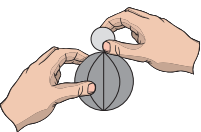 Introduction
Introduction
The collision of objects is a great way to demonstrate the conservation of momentum. Engage students by having them drop and collide toy balls of different mass and size. The results may be surprising! This inquiry-based activity will really get your students thinking about momentum.
Concepts
- Collisions
- Conservation of momentum
- Elasticity
Background
When an object is in motion, it has a property known as momentum. Momentum (p) is calculated by multiplying the mass (m) of the object by its velocity (v); p = mv. A fundamental principle of physics is that the momentum of an isolated system of objects always remains constant. This is known as the conservation of momentum. If objects within a system collide, the momentum of each individual object before and after a collision may change, but the total momentum of the system will remain constant.
There are two types of collisions—elastic and inelastic. An elastic collision occurs when objects collide and then separate after the collision. An example of an elastic collision is the collision between a baseball and a bat. An inelastic collision is when objects collide, stick together, and move as one object after the collision. An example of an inelastic collision is when a baseball hits a catcher’s mitt and stops. In every collision, elastic or inelastic, momentum is always conserved.
Click here to download the complete activity
Website: https://www.flinnsci.ca/
Facebook: https://www.facebook.com/flinnscientificcanada


 Introduction
Introduction